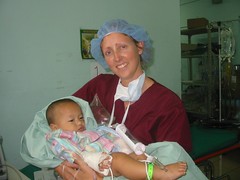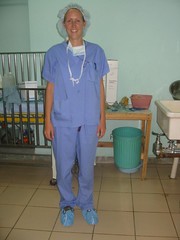More about Honduras

These past few days I've been wrapping up all the paperwork for my trip to Honduras. There's lots of paperwork to be done: basically providing a list of all the procedures that we completed, and getting an estimated cost for all the services and supplies that were donated. During this process I discovered that the services of an administrator/translator (aka me) are worth approximately 4% of the services of a hand surgeon. Hmph.
I've posted some more photos from my trip. In this set, you'll see photos of people from the trip. There are no surgery photos in this batch, just photos of the group of doctors and nurses and some of a few people we treated. Even though we spent lots of time at the hospital (more than 80 hours in six days) we managed to find time to relax as well. We also went out to dinner most nights and had a big dinner Thursday night, inviting the hospital staff to join us.
I have also posted some >photos taken in the OR. [EDIT: I thought better of this, so this paragraph is purely theoretical.] along with descriptions of some of the things I learned and some of the procedures that the doctors did. Some of the photos might gross you out but I tried to keep the gore factor to a minimum. Unless you're extremely sensitive, you should be fine. Also, I labeled the most graphic photos with a * in the name, so if you roll your mouse over the small images on the photoset page, you'll know which ones to watch out for. In some ways, though, these are the most fascinating. For example, you might see a tumor being removed, or tendons being repaired, bones being attached together with metal plates or my favorite, a pollicization. This was an 11-month-old child who was born with only a tiny little boneless nub of a non-functioning thumb. The surgeons detached the index finger and turned it into a fully functional opposable thumb (that's what a pollicization is). It's so cool to see the photo of the little hand (you can tell its size by comparing it to the size of the surgeon's fingers) and to think about the tiny tendons and nerves that were attached to the finger to make it into a thumb. Amazing! It was also great to think that because of this group of doctors, the little boy will grow up with two working hands, and that would never have happened otherwise.
Luckily I didn't have to learn too much tricky vocabulary. I was able to get by with the words I knew and stuck mainly to layman's terms (didn't have to learn the Spanish for "tenolysis", "contracture" or "dorsal ganglion"--I'm not even sure what the English words mean!) But I did come back with a slightly enhanced vocabulary: I know how to say "stitches", "tendons", "cyst", "splint", "dizziness", "thumb", "wrist", "nerves", "chart" and a few others. Next time I go out for Mexican food, I'll try to slip one or two of those into conversation with the waiter...












